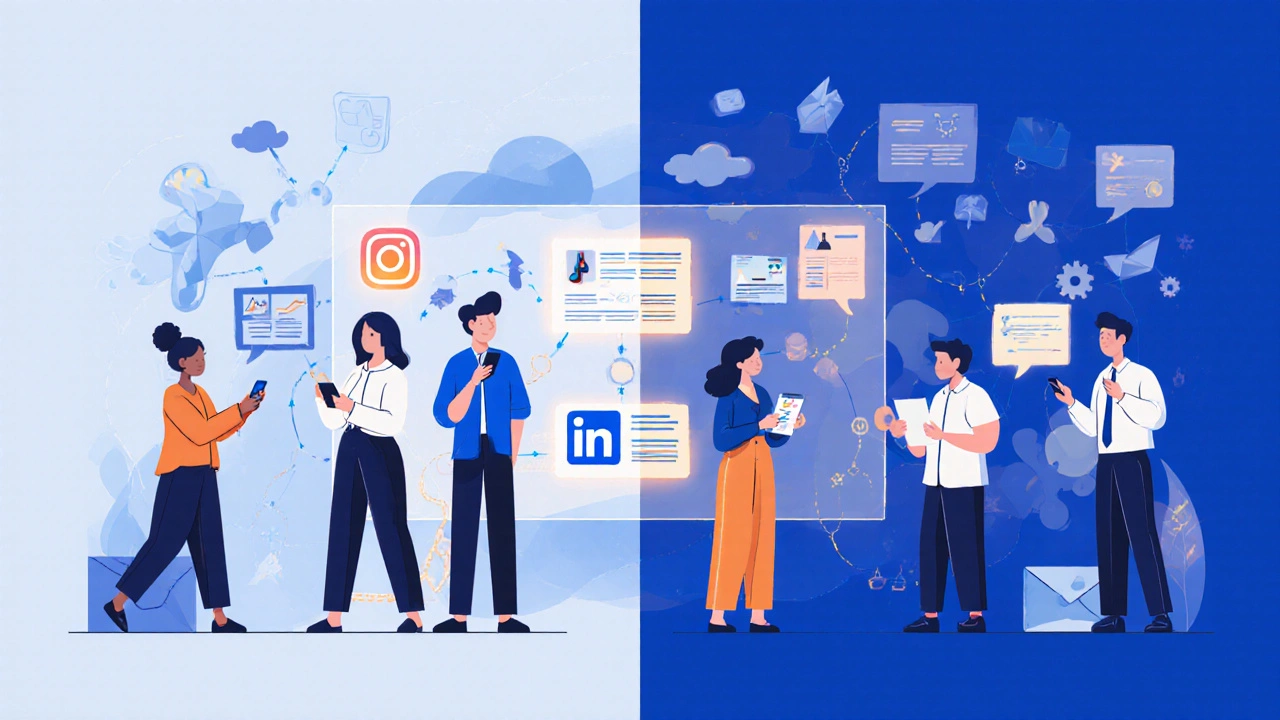Most businesses think a digital marketing strategy is just posting on Instagram, running Google Ads, and hoping for the best. But that’s not a strategy-it’s a guess. An effective digital marketing strategy is a clear, step-by-step plan that connects your business goals to real customer behavior. It’s not about doing more. It’s about doing the right things, at the right time, for the right people.
Start with your business goals, not your tools
Before you touch a single platform, ask: What do you actually want to achieve? More sales? Higher customer retention? More leads? The goal shapes everything else. If you don’t know your goal, your budget, content, and ad spend will be scattered. A local bakery in Perth might want to increase walk-in customers by 30% in three months. A SaaS startup might aim for 500 free trial sign-ups per month. Both need different tactics.
Write down one clear, measurable goal. Make it specific: "Increase email list sign-ups by 25% in 90 days" is better than "get more subscribers." Then work backward. What actions lead to that result? What data will tell you you’re on track?
Know your audience better than your competitors
You can’t market to "everyone." That’s why most campaigns fail. Effective digital marketing starts with knowing who your ideal customer really is. Not their age or location-though those matter-but their habits, frustrations, and what they search for at 2 a.m. when they can’t sleep.
Use free tools like Google Trends, Facebook Audience Insights, or even Reddit threads to see what people are asking. Talk to your best customers. Ask them: "What made you choose us?" and "What stopped you from buying sooner?" Their answers will reveal gaps in your messaging. If your audience is overwhelmed by technical jargon, simplify your language. If they’re comparing prices, highlight your warranty or support.
Build a simple customer profile: Name, job, pain points, where they hang out online, what content they trust. This isn’t fluff-it’s your blueprint.
Map the customer journey, not just the funnel
People don’t buy after seeing one ad. They move through stages: awareness, consideration, decision. Each stage needs different content and channels.
- Awareness: They don’t know they have a problem. Use blog posts, YouTube videos, or Pinterest pins that answer common questions. Example: "Why is my website loading slow?"
- Consideration: They know the problem and are comparing solutions. Use comparison guides, case studies, or webinars. Example: "Shopify vs WooCommerce: Which is better for small businesses?"
- Decision: They’re ready to buy. Use testimonials, free trials, or limited-time offers. Example: "Join 1,200+ businesses using our tool-see how it saved them 15 hours a week."
Don’t just push sales messages. Build trust at every stage. A customer who feels understood will convert faster-and stay longer.
Choose platforms based on behavior, not trends
TikTok isn’t magic. LinkedIn isn’t boring. What matters is where your audience spends time and what they do there.
If your customers are busy professionals, focus on LinkedIn and email. If they’re Gen Z shoppers, Instagram Reels and TikTok work better. If they’re researching high-ticket items, Google Search and YouTube reviews matter most.
Start with one or two platforms. Master them. Don’t spread yourself thin. A bakery in Perth might see 70% of its online orders come from Instagram Stories. That’s the platform to optimize. A B2B software company might get 80% of qualified leads from LinkedIn ads and targeted email sequences. That’s where they should invest.
Track where your traffic comes from. Use UTM parameters on every link. See which channels actually drive results-not just clicks.

Content is the engine, not the decoration
Content isn’t just blog posts and videos. It’s your product descriptions, your email subject lines, your chatbot replies, your FAQ page. Every word you publish either builds trust or erodes it.
Stop chasing viral content. Focus on consistent, helpful content that answers real questions. A plumbing company in Perth doesn’t need a funny meme. They need a guide: "How to fix a leaking tap without calling a plumber." That’s content that ranks, shares, and converts.
Repurpose everything. Turn a blog post into a carousel. Turn a webinar into 5 TikTok clips. Turn customer testimonials into Instagram Stories. One piece of great content can fuel months of posts.
Measure what matters, not what’s easy
Clicks, likes, and followers are vanity metrics. They look good on a slide but don’t pay the bills. Track outcomes:
- Cost per lead (CPL)
- Customer acquisition cost (CAC)
- Return on ad spend (ROAS)
- Email open-to-conversion rate
- Customer lifetime value (CLV)
Use Google Analytics 4 to track user paths. Set up conversion goals for sign-ups, purchases, or downloads. If your email campaign has a 5% conversion rate but your Facebook ads have 12%, shift budget. If your blog drives 40% of your sales but you only post once a month, post more.
Review your metrics every two weeks. Adjust. Don’t wait for the end of the quarter. Digital marketing moves fast. Your strategy must move faster.
Test, learn, repeat
There’s no perfect strategy. Only better versions of your current one. Test one thing at a time. Change the headline on your landing page. Try a new ad image. Send emails at 7 a.m. instead of 5 p.m. Small changes have big impacts.
Use A/B testing tools like Google Optimize or even Facebook’s built-in split testing. Run tests for at least 7 days. Don’t stop because one version looks better after 24 hours. Wait for statistically significant results.
Keep a log of what works and what doesn’t. Over time, you’ll build a playbook of proven tactics. That’s your real competitive advantage.
Automation saves time, not effort
Tools like Mailchimp, Hootsuite, or Zapier don’t replace strategy-they amplify it. Use automation for repetitive tasks: sending welcome emails, scheduling social posts, tagging leads in your CRM. But don’t automate your voice. People can tell when a message feels robotic.
Automate the process, not the personality. Your tone, your empathy, your unique perspective-that’s what makes your brand stand out. Let tools handle the busywork. You handle the connection.
What most people get wrong
They think digital marketing is about being everywhere. It’s not. It’s about being clear. It’s about knowing who you’re talking to, what they need, and how you’re the best solution. It’s about consistency over flash.
They chase trends instead of truth. They copy what competitors are doing instead of listening to their own customers. They measure activity, not impact.
The most effective digital marketing strategies aren’t flashy. They’re simple. They’re focused. They’re built on data, not guesses.
Start small. Stay consistent.
You don’t need a big budget. You don’t need a team of five. You just need clarity. Pick one goal. Know your audience. Pick one channel. Create one piece of helpful content. Track one metric. Do that for 30 days. Then adjust. Repeat.
That’s how real results happen-not from viral campaigns, but from steady, smart effort.
What’s the first step in building a digital marketing strategy?
The first step is defining a clear, measurable business goal. Without a goal, every tactic becomes a shot in the dark. Ask yourself: What do I want to achieve in the next 30 to 90 days? More sales? More leads? Higher customer retention? Once you have that, everything else-audience targeting, platform choice, content type-flows from it.
Do I need to be on every social media platform?
No. Being everywhere means being forgotten everywhere. Focus on one or two platforms where your audience actually spends time and engages. A B2B company should prioritize LinkedIn. A fashion brand targeting teens should focus on Instagram and TikTok. Track where your traffic and conversions come from, and double down there.
How often should I review my digital marketing strategy?
Review your metrics every two weeks. Look at what’s working and what’s not. Adjust your budget, content, or targeting based on real data-not gut feeling. A full strategy review should happen every 90 days, but small tweaks should be ongoing. Digital marketing moves fast; your plan should too.
What’s the biggest mistake businesses make with digital marketing?
The biggest mistake is focusing on activity instead of results. Posting daily doesn’t matter if no one converts. Chasing viral trends doesn’t help if they don’t bring in customers. Effective digital marketing is about connecting the right message to the right person at the right time-and measuring whether it actually moved the needle.
Can a small business compete with big brands in digital marketing?
Absolutely. Big brands have budgets, but small businesses have something more powerful: authenticity and agility. You can respond faster, personalize messages, and build real relationships. A local coffee shop in Perth can outmarket a national chain by sharing stories of its baristas, highlighting customer photos, and engaging in local Facebook groups. It’s not about spending more-it’s about connecting better.





